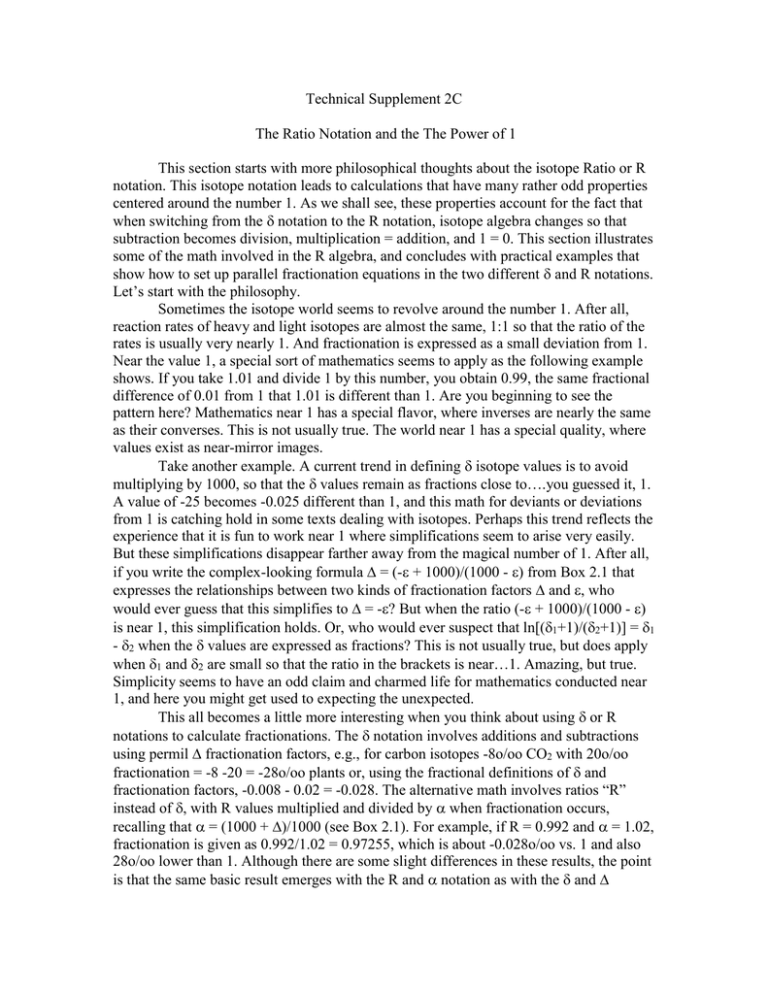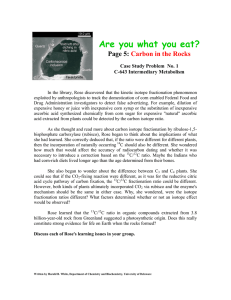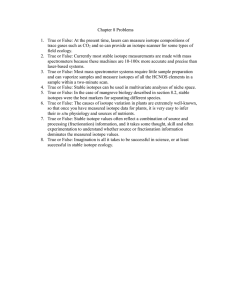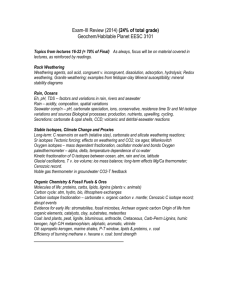Technical Supplement 2C.doc
advertisement

Technical Supplement 2C The Ratio Notation and the The Power of 1 This section starts with more philosophical thoughts about the isotope Ratio or R notation. This isotope notation leads to calculations that have many rather odd properties centered around the number 1. As we shall see, these properties account for the fact that when switching from the notation to the R notation, isotope algebra changes so that subtraction becomes division, multiplication = addition, and 1 = 0. This section illustrates some of the math involved in the R algebra, and concludes with practical examples that show how to set up parallel fractionation equations in the two different and R notations. Let’s start with the philosophy. Sometimes the isotope world seems to revolve around the number 1. After all, reaction rates of heavy and light isotopes are almost the same, 1:1 so that the ratio of the rates is usually very nearly 1. And fractionation is expressed as a small deviation from 1. Near the value 1, a special sort of mathematics seems to apply as the following example shows. If you take 1.01 and divide 1 by this number, you obtain 0.99, the same fractional difference of 0.01 from 1 that 1.01 is different than 1. Are you beginning to see the pattern here? Mathematics near 1 has a special flavor, where inverses are nearly the same as their converses. This is not usually true. The world near 1 has a special quality, where values exist as near-mirror images. Take another example. A current trend in defining isotope values is to avoid multiplying by 1000, so that the values remain as fractions close to….you guessed it, 1. A value of -25 becomes -0.025 different than 1, and this math for deviants or deviations from 1 is catching hold in some texts dealing with isotopes. Perhaps this trend reflects the experience that it is fun to work near 1 where simplifications seem to arise very easily. But these simplifications disappear farther away from the magical number of 1. After all, if you write the complex-looking formula = (-+ 1000)/(1000 - ) from Box 2.1 that expresses the relationships between two kinds of fractionation factors and , who would ever guess that this simplifies to = -? But when the ratio (-+ 1000)/(1000 - ) is near 1, this simplification holds. Or, who would ever suspect that ln[(1+1)/(2+1)] = 1 - 2 when the values are expressed as fractions? This is not usually true, but does apply when 1 and 2 are small so that the ratio in the brackets is near…1. Amazing, but true. Simplicity seems to have an odd claim and charmed life for mathematics conducted near 1, and here you might get used to expecting the unexpected. This all becomes a little more interesting when you think about using or R notations to calculate fractionations. The notation involves additions and subtractions using permil fractionation factors, e.g., for carbon isotopes -8o/oo CO2 with 20o/oo fractionation = -8 -20 = -28o/oo plants or, using the fractional definitions of and fractionation factors, -0.008 - 0.02 = -0.028. The alternative math involves ratios “R” instead of , with R values multiplied and divided by when fractionation occurs, recalling that = (1000 + /1000 (see Box 2.1). For example, if R = 0.992 and = 1.02, fractionation is given as 0.992/1.02 = 0.97255, which is about -0.028o/oo vs. 1 and also 28o/oo lower than 1. Although there are some slight differences in these results, the point is that the same basic result emerges with the R and notation as with the and notation. If you work further with these types of examples and examine the two sets of equations closely, i.e., the additions and subtractions involving and vs. those multiplications and divisions involving R and , you will find some differences, especially when values depart greatly from…..you guessed it, 1. The exact equations for fractionation are actually those for R and , but are closely approximated by the and algebra....as long as you are close to 1. (Technical Note: Mixing is not truly exact for either set of notation (see Table 2.2 above), and partly for this reason and partly because scientists normally report values in terms of , this book uses the -based notation for most calculations. Truly exact equations that incorporate both mixing and fractionation are presented in Section 4.6 and listed in the Appendix at the end of this printed book). But let’s return to our theme, the power of 1. You may have noticed that the scale does not look like it is close to 1. But if you look at the definition = (RSAMPLE/RSTANDARD – 1)*1000, and strip away the “*1000” and the “-1” in the definition, what do you find at the core of a value? It is a complex-looking ratio of ratios, but it simplifies to, you guessed it, a value near….1. So, because values contain RSAMPLE values that are near the RSTANDARD values, the ratio RSAMPLE/RSTANDARD has the special advantages of being near 1. You just have to embrace the dialectic that a 0o/oo value means that a value of 1 is present at the ratio-of-ratios core of the definition, i.e., 0 = 1 at the core of isotope math. If you embrace this mystical bit of reasoning, you are well on your way to understanding isotope maths. But what is the point of all of this? Perhaps this is just a bit of isotope appreciation, a special mathematical glow that accrues from working with 1. The power of 1 is not obvious in the beginning, but much of the math of isotopes swivels and swirls around 1, reflecting the basic similarity in the heavy and light isotopes. And poised in this special place, it turns out that there are many somewhat magical mathematical properties when numbers are near 1. Especially important for isotopes is that inverses and reverses come out about the same no matter which side of 1 you are on, the top side >1 or the bottom side <1. That is the bottom-dweller’s opinion from Mr. Polychaete. For your reference, here are some equations written both ways, in terms of using subtraction and addition, and in terms of the ratio (R) notation using division and multiplication. Being able to use both approaches allows you easier access to the wider isotope literature where both sets of approaches are commonly used. 1) Fractionation during formation of a product from a source material PRODUCT = SOURCE - and RPRODUCT = RSOURCE/ where is the permil fractionation factor for the faster reaction of the light-than-heavy isotopes expressed in positive units, is the fractionation factor for the faster reaction of the light-than-heavy isotopes and is typically slightly greater than 1, = (1000 + /1000, and R is the ratio of heavy-to-light isotopes in the source material. 2) Fractionation during a two-way exchange reaction between two substances, A and B, i.e., A reacts to form B in a forward reaction while B is also reacting to form A in a reverse reaction: A – 1 = B – 2 RA/1 = RB/2 where the subscripts 1 and 2 respectively represent the forward and reverse reactions. 3) Fractionation in a steady-state reaction chain consisting of a source and a downstream pool, where inputs from the source equal outputs from the pool: Input to Pool = Output from Pool SOURCE – 1 = POOL – 2 so that POOL = SOURCE – 1 + 2 RSOURCE/1 = RPOOL/2 so that RPOOL = RSOURCE2/1) Overall, there is an important parallelism at work in each of these examples. The parallelism is that each time when moving from the notation to the R-based notation, division substitutes for subtraction and multiplication substitutes for addition. In a larger sense these following parallelisms hold across the notations: equates to R, equates to , subtraction equates to division, and addition equates to multiplication. More examples of these parallelisms are available in Fry (2003) where is used in a slightly different sense, i.e., denotes the slower reaction of heavy-than-light isotopes and has values typically slightly less than 1. If you think this practice of switching fractionation definitions is confusing, you are right. Unfortunately, there is really no solid consensus in the isotope literature about which fractionation terminology is correct, and authorities caution that readers must always check the individual study to see how terms are defined (Hayes 2004). Perhaps this is the disadvantage of 1, that it is easy to switch from one side of 1 to the other in these R and definitions, leading to the extra burden of keeping track of definitions as you read the isotope literature.






